

The Advantages and Disadvantages of M Learning in Education. Potentials of Mobile Technology for K-12 Education: An Investigation of iPod touch Use for English Language Learners in the United States on JSTOR. Making a Case for Mobile Learning in K-12 Schools. Pedagogical Practices of Mobile Learning in K-12 and Higher Education Settings. Abachi, H.
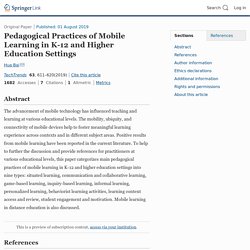
R., & Muhammad, G. (2014). The impact of m-learning technology on students and educators. Computers in Human Behavior, 30, 491–496.Article Google Scholar Ahmed, S., & Parsons, D. (2013). Abductive science inquiry using mobile devices in the classroom. Handbook of Research on K-12 Online and Blended Learning. Mobile Learning Initiatives in K-12 Schools: IP&T 286-005: Instructional Tech in Teaching. The Use of Mobile Learning in Grades K–12: A Literature Review of Current Trends and Practices: Peabody Journal of Education: Vol 95, No 2. Models of good teaching practices for mobile learning in higher education. In recent years, the use of mobile devices in education (mainly smartphones and tablets) is becoming increasingly important.
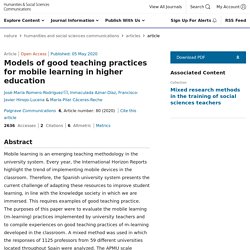
The Horizon Reports have been highlighting this trend for some years now, specifying that mobile learning (m-learning) will be implemented in one year or less at the higher education stage (Alexander et al., 2019). This indicates the importance attached to the application of this resource in the classroom. Thus, m-learning is defined as the use of mobile devices to support the teaching–learning process (Díez et al., 2017). The potential of the use of mobile devices in education lies in their main characteristics, which are the mobility they allow, ubiquity (being able to be used at any time and place), lightness, low cost, and connectivity (Arain et al., 2019).
In this way, m-learning contributes to the transformation of teaching practice (Boude, 2019), since it is based on the current of student-based teaching, where the teacher acts only as a guide to learning. The use of mobile learning in higher education: A systematic review. Highlights The majority of the studies focused on the impact of mobile learning on student achievement.
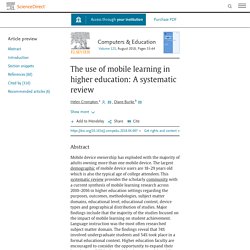
Language instruction was the most often researched subject matter domain. Of the studies, 74% involved undergraduate students. Of the studies, 54% took place in a formal educational context. Abstract Mobile device ownership has exploded with the majority of adults owning more than one mobile device. Keywords. EJ1102943. Exploring Students' Mobile Learning Practices in Higher Education. Key Takeaways A university-wide survey on students' mobile learning practices showed that ownership of mobile devices is high among students and that tablets are the most popular devices for academic purposes.The survey also found that mobile learning typically occurs outside the classroom, with only limited guidance from instructors.To improve mobile learning effectiveness, students and instructors need help adopting more effective learning and teaching practices across content areas.
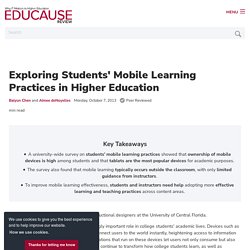
Baiyun Chen and Aimee deNoyelles are instructional designers at the University of Central Florida. Mobile technologies are playing an increasingly important role in college students' academic lives. Devices such as smartphones, tablets, and e-book readers connect users to the world instantly, heightening access to information and enabling interactivity with others. The popularity of mobile technologies among college students is increasing dramatically.
Key Issues Methods Survey Results. EJ920735. Mobile Learning. Mobile devices transform classroom experiences and student/instructor relationships to learning. Two years ago, four instructional designers in the University of California System decided to undertake a research project on “mobile learning.”
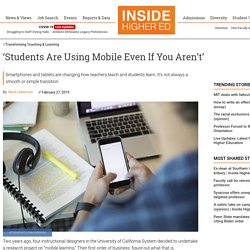
Their first order of business: figure out what that is. “It’s just so new that the researchers who have been trying to define it have found it so dynamic,” said Mindy Colin, an instructional consultant at the University of California, Santa Barbara. They eventually settled on a definition from Educause: "Using portable computing devices (such as iPads, laptops, tablet PCs, PDAs and smartphones) with wireless networks enables mobility and mobile variation related to instructional approaches, disciplines, learning goals and technological tools. " But they still struggled to define for themselves the parameters of their investigation. One professor they interviewed helped them accept the ambiguity of their research subject. This anecdote underscored for them that mobile learning means different things to different groups across higher education. Investigating attitudes of mobile learners in higher education.
Everything You Ever Wanted To Know About Mobile Learning. Many benefits of mobile learning exist, but the most important advantage is that information can be accessed anytime, and anywhere the user can safely use their mobile device.
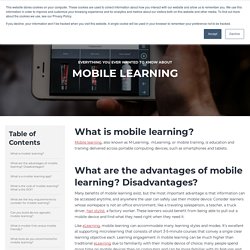
Consider learners whose workspace is not an office environment, like a traveling salesperson, a teacher, a truck driver, hair stylist, a factory worker. These learners would benefit from being able to pull out a mobile device and find what they need right when they need it. Like eLearning, mobile learning can accommodate many learning styles and modes. It’s excellent at supporting microlearning that consists of short 3-5-minute courses that convey a single clear learning objective each.
10 Stats That Prove Mobile Learning Lives up to The Hype. It shouldn’t come as any surprise that the momentum of mobile technologies hasn’t shown any signs of slowing down.
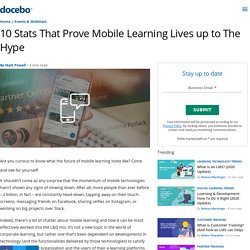
After all, more people than ever before – 2 billion, in fact – are constantly head-down, tapping away on their touch-screens, messaging friends on Facebook, sharing selfies on Instagram, or working on big projects over Slack. Indeed, there’s a lot of chatter about mobile learning and how it can be most effectively worked into the L&D mix. It’s not a new topic in the world of corporate learning, but rather one that’s been dependent on developments in technology (and the functionalities delivered by those technologies) to satisfy the needs of learning organization and the users of their e-learning platforms.
Mobile Learning Transforming Education. Now Is the Time to Embrace Mobile Learning. The circumstances of the COVID-19 pandemic highlight the opportunities and benefits that mobile technologies can provide to students and instructors as they learn and teach in unusual times.
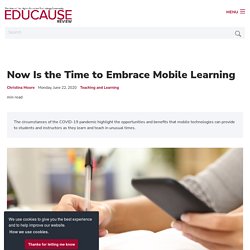
We drive so little these days that letting my young kids play in our minivan in the garage has become a favorite activity when the weather isn't favorable to play outside. During our last "road trip to nowhere," I read through some teaching and learning articles I had saved on Instapaper. How Mobile Learning Can Support Global Student Engagement. National Taiwan Normal University's device-agnostic in-class engagement tool was featured as a mobile learning exemplar project in the EDUCAUSE Horizon Report: 2019 Higher Education Edition.
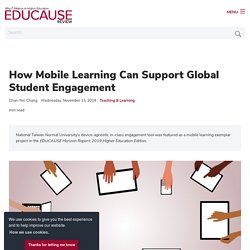
Given the prevalence of smartphones and mobile devices and access to high-speed internet, more K-12 schools are embracing a bring-your-own device (BYOD) policy to make learning more engaging, enjoyable, and effective. In keeping with this trend, a proliferation of edtech offerings have been developed to transform smartphones into powerful interactive tools for classroom learning.
My team at National Taiwan Normal University (NTNU) developed one such tool, CloudClassRoom (CCR), which was featured as a mobile learning exemplar project in the EDUCAUSE Horizon Report: 2019 Higher Education Edition.1 To date, approximately 50,000 teachers and students have registered on CCR, and more than 500,000 classroom activities have been conducted using the technology. Mobile Learning Education Benefits and Challenges. Basic Characteristics of Mobile Learning. What is Mobile Learning? (M-Learning) Ever since we tossed out our flip phones and moved on to internet enabled devices, content consumption has flipped on its head.
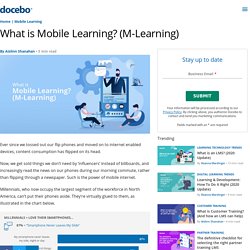
Now, we get sold things we don’t need by ‘influencers’ instead of billboards, and increasingly read the news on our phones during our morning commute, rather than flipping through a newspaper. Such is the power of mobile internet. Millennials, who now occupy the largest segment of the workforce in North America, can’t put their phones aside. They’re virtually glued to them, as illustrated in the chart below. Youtube. Mobile Learning: More than just Mobile + Learning. Mobile learning is creating a lot of excitement in the learning community. According to a report published by Ambient Insight Research, the US market for mobile learning products and services reached $958.7 million in 2010. They project that revenues will reach $1.82 billion by 2015. Moodle. There is no question that mobile devices are changing corporate learning forever.
However, this doesn’t mean classroom-based training or formal eLearning courses are going away, it just means the mobile movement is demanding companies to rethink their training strategies and to create learning programs especially for mobile devices. "Within the next five years, we are going to be not just changing but transforming how we train and educate based on mobile," predicts Daniel Burrus, chief executive officer of Burrus Research Associates Inc., a Hartland, Wis.
The Definition Of Mobile Learning. By Terry Heick What is the definition of mobile learning? For starters, let’s agree that mobile learning is learning based on mobility often through mobile devices like laptops and smartphones, iPads, and wearable technology. Of course, there’s more to it than that. Years ago, I created a graphic that laid out some of the principles of mobile learning, which included Access, Transparency, Self-Actuation, and Metrics. For a briefer definition of mobile learning, we might offer that it is ‘a kind of learning characterized by the need and ability of the learner to be mobile.’
What Is Mobile Learning? Mobile learning, also known as mLearning, is defined as the need and ability to learn through virtual media, such as personal electronic gadgets, social interactions, and content. Devices that can be used for mLearning include smartphones, tablets, laptops, and digital notebooks. It focuses on the learners’ freedom of movement and their interaction with technology. In this case, simplifying learning by using mobile tools is what constitutes this informal learning setup. DePaul University, Chicago. What is MoLI? MoLI is the Mobile Learning Initiative at DePaul, a collaborative effort between the Center for Teaching and Learning (CTL), DePaul Library, School of Continuing and Professional Studies, Teaching Commons, and Media Production and Training.
You can contact the team at MoLI@depaul.edu.. Newsletter Signup What is MoLI? Youtube. Moodle.